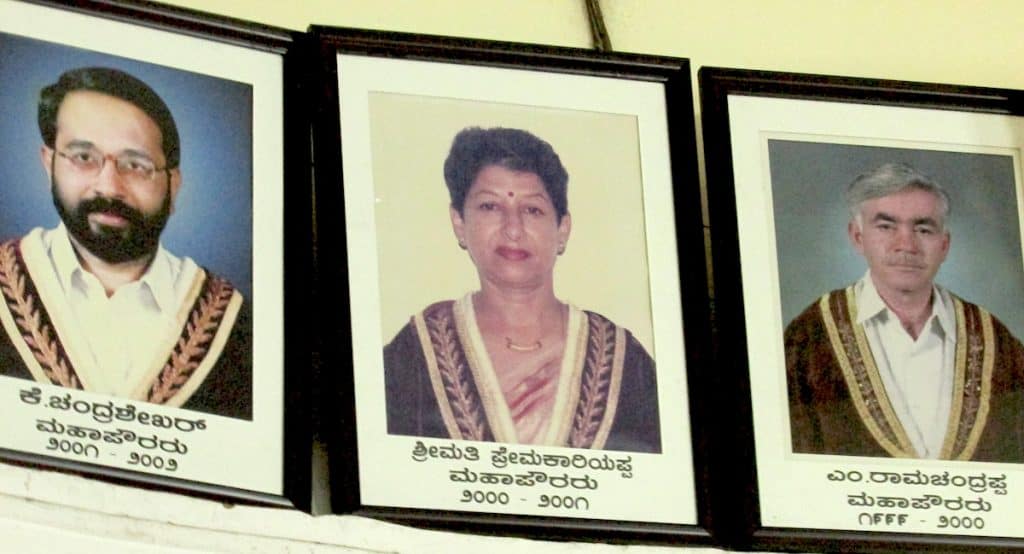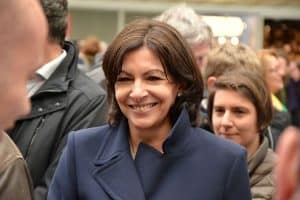
Mayors Gallery at BBMP. Pic: Akshatha M.
It seems an unlikely possibility at this time for Bengaluru to have a powerful and accountable Mayor who actually has a say in the way our city is run. This democratic innovation in local governance which has paid rich dividends around the world however hasn’t caught the imagination of the public at large in our city.
Blame it on political calculation or public aversion to voting in one more election (should we go down the path of having a directly elected Mayor), a change in this direction would herald a major change in the way power is decentralized in the real sense of the term. However, the first challenge is to have the citizens imagine a larger role for the Mayor that would encourage a more robust and involved local governance.
Our present reality is slightly different. The Mayor of Bengaluru is a little more than a figurehead – a figure in a ceremonial robe who primarily cuts ribbons for most of their year-long tenure and receives foreign dignitaries as protocol demands. The importance of the post is such that the BBMP doesn’t even carry a list of all the Mayors of the city on its website. The only list available hangs in a forgotten corner in the Mayor’s chamber along with faded photographs of those from previous times.
The mayors have little to do outside of the Corporation Council (or inside it for that matter); have no say in the planning of Bengaluru; are not even direct appointees to the Bengaluru Metropolitan Planning Committee or make budget allocations. They are decorative at best and invisible at worst.
In contrast, the Mayor of London controls an annual budget of £17billion that invests in urban mobility, housing, art and culture and even policing. In 2001, Time magazine named Rudy Giuliani, the mayor of the City on New York as its Person of the Year for his leadership during the 9/11 tragedy. Eduardo Paes, the former mayor of Rio De Janeiro created an integrated operations centre to allow collaboration of transit workers, first responders and city workers and help minimize response time during a crisis and better civic platform.

To combat air pollution in the city, Anne Hidalgo oversaw the introduction of a scheme called “Paris Respire” (literally “Paris Breathes”), which included banning all cars from certain areas of Paris on the first Sunday of the month, as well as making public transport and the city’s bicycle and electric vehicle schemes free for the day. She also worked further to reduce car usage, with an increase in the price of parking meters, a ban on free parking on certain days, and the conversion of certain sections of a highway along the River Seine into a riverside park. Source:Wikipedia. Pic: Wikimedia Commons
Helen Zille, the Mayor of Cape Town increased the number of rehabilitation centers to combat the growing problem of drug abuse in her city. Among the Asian countries, Park Won Soon, the Mayor of Seoul famously brought down a freeway that went through the middle of the city to revive a river that ran under it creating an unparalleled social space for it. Even in South Asia, Pakistan got one of its own shortlisted for the World Mayor Award in 2010. Syed Mustafa Kamal, the Mayor of Karachi, much like his Indian counterparts did not control public services. Instead he worked on bettering the environment with his “Green Karachi Project” that sought to bring back the green cover to his city.
This isn’t to say Bengaluru didn’t have its share of stalwarts. G Narayan and K V Krishna Iyer, two mayors of Bengaluru were supposed to have participated in the movement to bring Cauvery water to the city. Narayan even started the practice of listing and printing the program of works along with their budgets that were being undertaken by the Corporation to encourage its transparent working. T R Shamanna, an MP who became popular among the masses as Cycle Shamanna, was instrumental in abolishing the tax on cycles that were a common mode of transport at the time and even led a delegation to the Central government to negotiate terms to deal with the severe water and power crisis. These distinguished personalities were not always mayors. Even if they were, they too held just one year in office. Yet they were able to meet the challenges of a city that had not started its journey as a thriving cosmopolitan, with or without mayor’s post.
The last two decades have not been kind to Bengaluru. The city has been inundated with civic problems that the municipal corporation has struggled to deal with. Citizens who had had enough with red tapeism that was a bane of the administration pushed back. The democratic deficit among the people gave away to citizen activism that has now begun to demand accountability.
Many committees like Kasturirangan’s, ABIDe/BMRGA bill, and the Bengaluru Restructuring Committee have recommended that the Mayor be empowered:
“the challenge of governance in a complex metropolis like Bengaluru requires a new leadership paradigm which guarantees political and administrative dynamism and stability… BBMP should have a Mayor who is directly elected by the people with a fixed term of 5 years. The term of 5 years for the Mayor will allow him/her to emerge as a politically accountable leader at local government level with a democratic mandate comparable to political leaders at other levels of government. It is also recommended that the Mayor should be vested with executive powers of the Municipal Government”
So the question now is should we be re-imagining the structuring of local government too? It is a logical expectation that Municipal Corporations have a better understanding of city issues and therefore should be allowed a greater role in its planning and mayor becomes the conduit for these programs.
But before we ask the political establishment, it becomes paramount that we as citizens re-imagine the role of a mayor. A look around the world definitely presents as strong case to do this.
|
“We invite you to re-imagine the role and actions of a mayor – what would you do if you were one? Write an article and win a super prize. Click here»” |
Errata: T R Shammanna was erroneously identified as a Mayor of Bengaluru. He was in fact elected as a corporator to the Bangalore City Corporation from Basvangudi in 1957. He later became a MP and was also instrumental in abolishing the cycle tax during his tenure. We regret the error.
Dear Akshata,
There is a corrigendum in this article. The man, who was the Mayor and then the MP from Bangalore South was V.S. Krishna Iyer. The octogenarian passed away in 2011. I last met him in 2008 soon after my maternal grandmother’s death. He was quite disillusioned with the state of affairs at BBMP and politics in general.
Neither Narayan or Krishna Iyer had anything to do with getting Cauvery to Bangalore. That honour should actually go to “Bangalore Poura Samithi”. Poura Samithi was a citizen’s movement in late 1950 and early 1960. It was started by KNV Rao, KM Naganna, BS Basappa Shetty among others. They got the then Youth Congress leader, TR Shamanna to leave Congress and join Poura Samithi. The cycle tax, was withdrawn at the behest of Poura Samithi. The Samithi got a lot of political mileage and was successful in replacing Congress in Municipality [the first non-Congress formation in a large city post 1947]. This made Nijalingappa’s government adamant about not heeding to Poura Samithi’s demand to get Cauvery water. When things became hot and VR Naidu, then Malleswaram Congress MLA tried to raise the issue in Assembly, he was snubbed the CM as an agent of Poura Samithi. This angered Bangaloreans, who were then reeling under water shortage. In 1967 elections, 4 Poura Samithi members and one Poura Samithi supported CPI leader entered Assembly. This forced the Congress government to heed to popular pressure and consider the request. The politics of the time was equally caustic. Nijalingappa refused World Bank aid [got at the insistence of Jawaharlal Nehru] to spite the city. Krishna Iyer was a Congress Mayor and had no role to play in the water politics of the time. He rose in prominence during the emergency, when he joined the Janata Party and later became the Urban Development minister under RK Hegde.
One issue about Bangalore Mayors – even the government of RK Hegde, which got national acclaim for introducing a strong panchayat raj system in Karnataka, was against giving stronger powers to Mayors. If anything could have changed, that government was the best bet.
I would blame them for having spoilt the habits of Bangaloreans. We had over a 1000 lakes, Arkavathy, Kumudavathy and Dakshina Pinakini.
These should have been tapped into instead of drawing water from 120 kilometres away.
TR Shamanna was never Bangalore Mayor. I met him along with my father the day before his death in 1990. They were friends for six decades. He said “The biggest failure in my life is that I did not become Bangalore Mayor”. He loved the city and represented it in Parliament. He was also the Urban Development Minister, long time MLA and Corporator. This was how important the Mayor’s image was back then. We have now completely destroyed the institution.